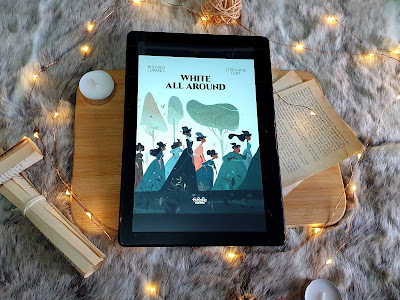'Canterbury, Connecticut, 1832: a charming female boarding school has found success among the locals, with two dozen girls enrolled. Some in town question the purpose of educating young girls—but surely there’s no harm in trying? At least not until the Prudence Crandall School announces its plans to start accepting black students. Thirty years before the abolition of slavery in the United States, in the so-called “free” North, these students will be met by a wave of hostility that puts the future of the school in question, and their very lives in peril. Even in the land of the free, not all of America’s children are welcome.'
One of the things that I really like about the books that Europe Comics puts out is that they're often inspired by real historical figures and events, even if they go on to do their own thing. I like this aspect of their books because it normally leads me to discovering something I never knew about a famous figure, or to discover a whole topic I've never heard about. White All Around falls into this second category, introducing me to an amazing part of history that I had no idea existed, but now want to learn so much more about.
The story follows school teacher Prudence Crandall, who runs a small boarding school for young woman in Caterbury, Connecticut in the 1830's. She's a well liked and well respected member of the local community, but this all changes one day when she decides to open her school to Black women. It begins when she welcomes Sarah into her classroom, a local girl who's been coming to her to ask questions and learn.
As you can expect from a period before slavery was made illegal, this does not go down well with the local community, or the parents of her white students. Knowing that she's going to be facing an almost impossible task of creating a learning environment for both Black and white students Prudence does the only thing she can, she makes her school exclusively for Black women. Thus begins her long battle to help and educate Black women from across the country, and the trials she faces as a result (some of them literal legal trials).
The book doesn't really spend a lot of time with Prudence, however, treating her more as a supporting character rather than the lead in the story. Much more of the focus is given over to a handful of her first students, framing the narrative around their experiences. There's Sarah, a local woman who travels to the school every day to attend classes, Eliza, Jeruska, Maggie, and her sister Dorothy, who've all travelled to attend the school. There's also Maria, who works for Prudence, but has chosen not to attend the school. It's through these women that we witness events unfold, whilst Prudence is in the background working for her rights to teach these women.
This mixture of characters are quite a fun group, as they're all very different from each other and often disagree on a lot of things. Through their discussions and arguments we get to see their different opinions on their education, the actions of the townsfolk, and things like religion and their own personal beliefs. Their religion is a fairly major secondary plot, as throughout the book we see Eliza being somewhat unwilling to pray with the others, and at one point the entire school is banned from attending the local church due to their race. But this story-line reaches a head when Eliza reveals that she prays deep in the woods, surrounded by nature, and that she believes god to be a beautiful Black woman. It's a beautiful moment where Eliza gets to talk about her belief in her version of god, and of the strength she and other women of colour have. Her faith gives her a sense of power and strength that she'd otherwise go without.
There are a lot of wonderful moments like this throughout the book, moments that look at the individual and persona struggles of being a Black person in a time where half the country still owned slaves, where you're being legislated against and hunted. There's a character called Feral, a young boy living in the woods, who has memorised the confession of Nat Turner and believes that he can truly be free running alone in nature. Through him we see a young man who's fighting against the society around him so that he can be himself, and even though he's doing no harm to anyone he's persecuted because of the colour of his skin.
The book has some wonderful artwork too, provided by Stephane Fert, who's style adds a certain degree of magic to the book. Instead of making things hyper realistic the book has an almost fairy tale quality to it. The characters are almost caricatures, with distinct and over the top looks, whilst the environments look like places out of a children's book, with the woods around the school having more in common with a wonderland forest than a real world place. But this style really helps the book. It makes what is at times a harsh and upsetting story easier to handle. There are points in the book that enraged me because of the injustice that these people had to face, if these moments were drawn in a more realistic style it would have made it harder to read; as it is, the moments of happiness and levity feel the more stronger and leave the book feeling hopeful and sweet.
White All Around is a great story, one that takes a little known part of history and gives it the spotlight, inspiring the reader to want to learn more about these people and the times they lived in.


No comments:
Post a Comment